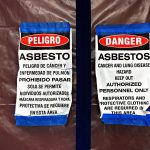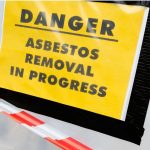Table of Contents
Asbestos on Shoes: A Hidden Danger
Asbestos fibers can cling to the soles of shoes if you walk through contaminated areas. This poses a risk as the fibers can later be inhaled and cause serious health problems. Here’s what you need to know about asbestos on shoes and how to stay safe.
Why Asbestos Fibers Stick to Shoes
Asbestos is a naturally occurring fibrous mineral that was commonly used as insulation and fireproofing in buildings until the 1970s. When old buildings containing asbestos are renovated or demolished, tiny asbestos fibers are released into the air and can settle onto surfaces, including the ground.
These microscopic fibers can cling to the soles and tread of shoes as you walk through contaminated areas. The fibers stick due to static electricity and moisture on the soles. The grooves and texture of shoes also provide places for the jagged asbestos fibers to lodge.
Dangers of Asbestos Fibers on Shoes
Asbestos is a known carcinogen. Inhaling or ingesting the microscopic fibers can lead to serious diseases like mesothelioma, lung cancer, and asbestosis decades later. Even small amounts are dangerous.
When asbestos fibers are stuck to the bottom of shoes, they can later get kicked up into the air where they can be inhaled. They can also be tracked into homes and buildings, spreading contamination.
 Protecting Yourself from Asbestos on Shoes
Protecting Yourself from Asbestos on Shoes
Here are some tips to avoid exposure from asbestos fibers clinging to shoes:
- Avoid walking through areas known to be contaminated with asbestos, such as construction or demolition sites of older buildings.
- Wear disposable shoe covers when entering potentially contaminated areas.
- Leave your shoes outside when entering your home after being in an area that may contain asbestos.
- Wash work shoes frequently to remove any fibers.
- Wet wipe shoes before entering your vehicle to avoid tracking in fibers.
- Have shoes professionally cleaned at an asbestos remediation company if highly contaminated.
Asbestos Exposure FAQ
How are you exposed to asbestos?
The main ways people are exposed are inhaling asbestos fibers in the air or ingesting fibers. This can happen when asbestos-containing materials are disturbed, releasing fibers that can be inhaled or swallowed. It can also occur when asbestos on clothing, shoes, or other objects creates dust that gets in the air.
What are the symptoms of asbestos exposure?
There are often no immediate symptoms. Asbestos-related diseases like mesothelioma can take 10-50 years to develop after exposure. When symptoms do occur, they include shortness of breath, a persistent cough, chest pain, unexplained weight loss, and fatigue.
Is there a safe level of asbestos exposure?
There is no known safe level of asbestos exposure. That’s why it’s so critical to prevent any exposure in the first place. Even small amounts can potentially cause health issues down the road.
Can asbestos exposure be fatal?
Yes, asbestos exposure can lead to deadly diseases. The two main causes of asbestos-related deaths are mesothelioma and lung cancer. The prognosis for these diseases is poor, so preventing exposure is critical.
Should I get tested for asbestos exposure?
There is no general screening test for asbestos exposure. Doctors may order imaging tests like CT scans or MRIs if you have symptoms of an asbestos-related disease. The best step is to prevent any exposure in the first place.
Can asbestos cause cancer?
Yes, asbestos is a known carcinogen. Inhaling asbestos fibers can cause lung cancer and mesothelioma, a rare cancer of the lining of the lungs and abdomen.
Is there a cure for asbestos poisoning?
There is no cure for diseases caused by asbestos, like mesothelioma. Treatment focuses on slowing the progression of the disease and managing symptoms. Again, this highlights the importance of preventing any exposure in the first place.
For more information, visit the EPA’s asbestos webpage.








